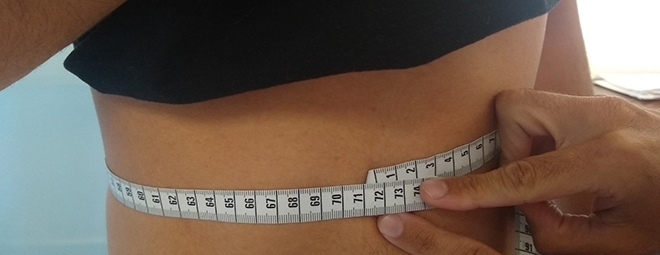

Physically active men who are not overweight but who have a relatively high waist-stature ratio are more likely to develop heart disorders, according to a study by Brazilian researchers (photo: Vitor Engrácia Valenti)
Physically active men who are not overweight but who have a relatively high waist-stature ratio are more likely to develop heart disorders, according to a study by Brazilian researchers.
Physically active men who are not overweight but who have a relatively high waist-stature ratio are more likely to develop heart disorders, according to a study by Brazilian researchers.

Physically active men who are not overweight but who have a relatively high waist-stature ratio are more likely to develop heart disorders, according to a study by Brazilian researchers (photo: Vitor Engrácia Valenti)
By Elton Alisson | Agência FAPESP – Health experts have warned for years that men and women with excess abdominal fat run a greater risk of developing cardiovascular problems. However, individuals with abdominal or central obesity are not the only ones in danger, according to a new study.
The study found that physically active men who were not overweight but whose waist-stature ratio (WSR) was close to the risk threshold were also more likely to develop heart disorders than individuals with lower WSRs.
The study was conducted by Brazilian researchers affiliated with São Paulo State University (UNESP) in Presidente Prudente and Marília in collaboration with colleagues at Oxford Brookes University in the UK. The study resulted from a research project supported by FAPESP and is published in the journal Scientific Reports.
“We found that non-overweight, physically active, healthy individuals without a history of metabolic or cardiovascular disease but with WSRs close to the risk factor limit were more likely to develop heart disorders than individuals with less accumulated fat in the waist area,” Vitor Engrácia Valenti, a professor at UNESP Marília and principal investigator for the study, told Agência FAPESP.
According to Valenti, recent research suggests that the WSR (waist circumference divided by height) is a more accurate predictor of cardiovascular risk than the body mass index (BMI), a widely used measure of body fat.
The researchers further investigated this hypothesis by analyzing the autonomic recovery of heart rate after aerobic exercise in healthy men with different WSRs. To this end, 52 physically active healthy men aged 18-30 were divided into the following three groups according to WSR: between 0.40 and 0.449, which is below the risk threshold for cardiovascular disease; between 0.45 and 0.50, which is close to the threshold; and between 0.50 and 0.56, which is above the threshold.
The participants were tested on two separate days with a 48-hour interval between the two tests. On the first day, they remained seated and at rest for 15 minutes, and then performed a maximum effort test on a treadmill. After this bout of aerobic exercise, they remained standing and at rest for three minutes and then seated and at rest for the next 57 minutes, totalling one hour of recovery from the exertion.
“This test proved they were all physically active. They weren’t athletes, but they were in the habit of playing soccer on weekends, for example,” Valenti said.
On the second day, they warmed up for five minutes, and then ran at 60% of their maximum effort for 25 minutes.
Their heart rate and heart rate variability were measured while at rest and six times during the recovery hour to assess their speed of autonomic recovery after physical activity.
“Autonomic heart rate recovery time is a good indicator of the risk of cardiovascular complications immediately after aerobic exercise and of developing heart disease,” Valenti said. “If the heart rate takes a long time to return to normal, this indicates that the individual runs a significant risk of developing a heart disorder.”
Interaction with nervous system
Analysis of the measurements showed that the autonomic recovery was slower in the groups with WSRs close to and above the risk threshold for heart disease after both the maximum effort test and moderate aerobic exercise.
“We found that volunteers in the group with WSRs close to the risk limit were also more likely to develop cardiovascular disorders,” Valenti said.
The researchers at UNESP performed statistical analyses involving correlation coefficient tests and linear regression models to look for significant links between WSRs and heart rate variability after physical activity.
The results of the statistical analyses suggested that two factors were most significantly correlated during the first ten minutes of the postexercise recovery period, when the parasympathetic nervous system (PNS) was being reactivated. Among other functions, the PNS, one of the three divisions of the autonomic nervous system, slows heart rate and reduces blood pressure via the release of hormones.
“We found that PNS activity diminished as WSR increased. This heightens the risk of cardiovascular disturbance,” Valenti said.
The article “Waist-stature ratio and its relationship with autonomic recovery from aerobic exercise in healthy men” (DOI: 10.1038/s41598-018-34246-5) by Anne Michelli G. G. Fontes, Letícia S. de Oliveira, Franciele M. Vanderlei, David M. Garner and Vitor E. Valenti can be read at: www.nature.com/articles/s41598-018-34246-5.
Republish
The Agency FAPESP licenses news via Creative Commons (CC-BY-NC-ND) so that they can be republished free of charge and in a simple way by other digital or printed vehicles. Agência FAPESP must be credited as the source of the content being republished and the name of the reporter (if any) must be attributed. Using the HMTL button below allows compliance with these rules, detailed in Digital Republishing Policy FAPESP.





